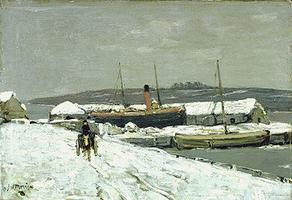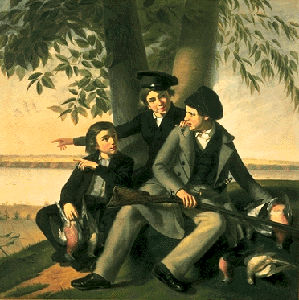James Wilson Morrice
James Wilson Morrice, painter (b at Montréal 10 Aug 1865; d at Tunis, Tunisia 23 Jan 1924). Morrice was one of the earliest Canadian modernist painters and the first Canadian to achieve widespread acceptance abroad. Born of a wealthy and strictly Presbyterian merchant family, he showed an early interest in painting. His father wanted him to enter law and, after studying at the University of Toronto and Osgoode Hall, he was called to the Ontario Bar in 1889, but never practised. Montréal dealer William Stewart advised him to study abroad and Sir William Van Horne, recognizing his talent, persuaded his father to finance his art studies in Europe. He began his studies at the Académie Julian in Paris in 1890 but soon sought individual masters, first the Barbizon painter Henri Harpignies, then the American painter James McNeill Whistler. But it was in Venice, which he visited with Maurice Cullen in 1896, that the peculiar light effects changed his perception and set him on his course as a painter.
Morrice never returned to live in Canada, but each year until his father died in 1914 he visited and painted the extraordinary winter sketches and pictures of Québec City and its environs that represent the Canadian side of his work. Paris remained for many years the centre of his world. He became one of the Left Bank expatriate painters and writers, and frequented cafés such as the Chat Blanc in Montparnasse, where he associated with Whistler and Charles Conder and English writers Arnold Bennett and Somerset Maugham, who portrayed him as a minor character in their books. They record his wit, his bibulous geniality, and his habit of making quick oil studies on small wood panels. These sketches were always the start of Morrice's paintings. He made hundreds, some later worked up into canvases. At first he was influenced by the late Impressionists, notably Bonnard and Vuillard, but from about 1909, when he met Henri Matisse, he moved towards the Fauves, with their more violent colouring and their stronger and more rhythmical composition. At the same time he visited North Africa. There, and in the Caribbean, to which he first travelled in 1915, he encountered the clear, strong tones of his later palette. Yet even at its most opulent, his painting was never strident in colour; it never lost his special delicacy and translucency.
The years of WWI were particularly disruptive. The Paris café life dwindled away; he went to London but found the climate difficult. He spent a period as a Canadian war artist and in this role painted a most uncharacteristic work - a mural of an endless line of soldiers marching through the mud of a battlefield. When the war ended, he spent more of his time in countries where the warmth was kind to his health and the colours and light inspired him as a painter. He was critically ill at Montreux, Switzerland, in 1922; when he went on to North Africa the rumour reached Paris that he was dead, and in 1923 some friends organized a retrospective exhibition. He died in reality a few months later.
Morrice's fame in his native country was almost entirely posthumous. Though he was a member of the short-lived Canadian Art Club, 1907-15, and was elected to the Royal Canadian Academy in 1913, he was mainly appreciated by a few fellow painters, and it was not until after his death that the first major exhibitions of his work were held in Canada. In Europe, however, he began to gain recognition in the early 1900s. In Paris, he exhibited regularly at the modernist Salon d'Automne, of which he became a vice-president. The more advanced French painters accepted him, and before Canadian galleries were acquiring his paintings on any scale, Morrice's work was moving into the great European public collections.
Morrice was a painter who bestrode 2 worlds. His work finds a place in the European modernist tradition and his tropical paintings have an exoticism of colour and spirit that few Canadian painters paralleled until recently. Yet his winter paintings of Québec, which include among them some of his most famous canvases, such as The Ferry, Québec, and The Ice Bridge, are so distinctive in their cold light and stark forms that one cannot think of them as anything but Canadian. They are among the first truly great Canadian paintings.

 Share on Facebook
Share on Facebook Share on X
Share on X Share by Email
Share by Email Share on Google Classroom
Share on Google Classroom







